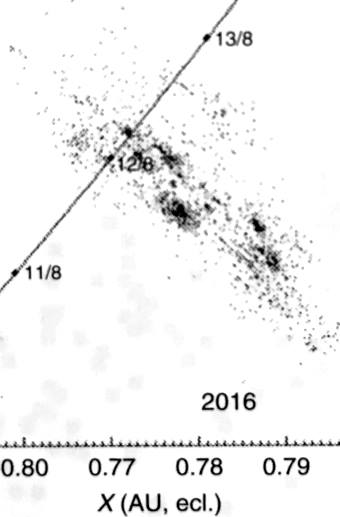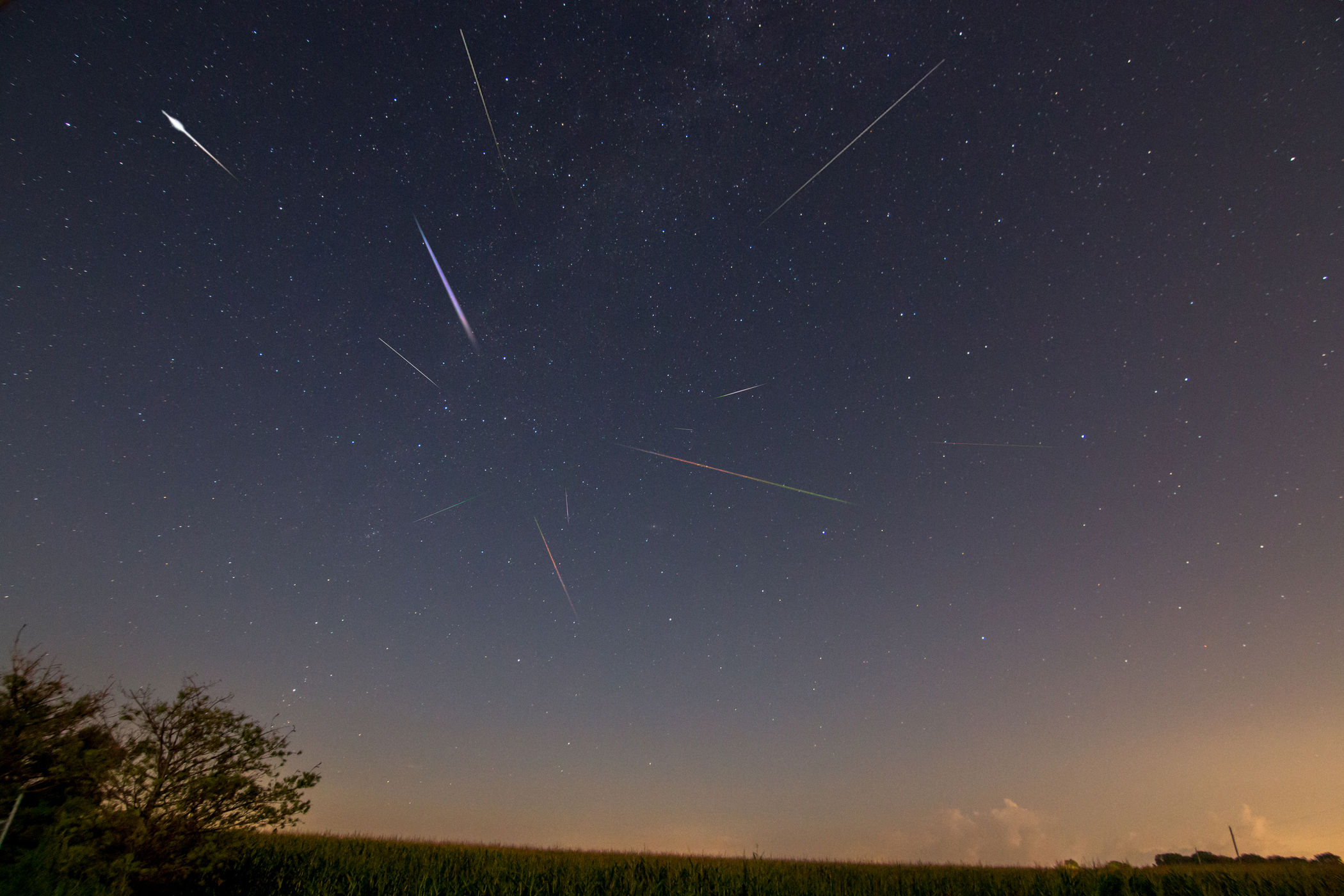In the past few days, however, I was at CERN and could afford going out to observe the night sky, so it made sense to spend at least a couple of hours to check on the peak activity of the Perseids, which this year was predicted to be stronger than usual.
Meteor showers occur when the Earth's orbit intersects the filament of dust left by comets or other celestial bodies (yes, there are showers connected to asteroids). The filaments loosely follow the originating object's trajectory, but are influenced by gravitational interactions with planets (mostly Jupiter). Their dynamics is mostly predictable, once you have a good density model of the particles they are made of. So we have pretty precise predictions nowadays, on which to rely if we must decide to watch a movie or spend time out in the cold.
 The predictions are produced by competing group of planetary astronomers, and they can be plotted in graphs like the one on the right, which are only qualitatively showing what is going on (the line shows the Earth's path across the dust trail), or tabled in ZHR expectations versus time. The ZHR is an empirical measure of the rate of observable meteors. It means "Zenit hourly rate" and it is computed by "renormalizing" rates to what an observer with perfect vision would see if he or she was looking at a perfectly clear and dark sky, when the radiant point of the shower was at the zenit.
The predictions are produced by competing group of planetary astronomers, and they can be plotted in graphs like the one on the right, which are only qualitatively showing what is going on (the line shows the Earth's path across the dust trail), or tabled in ZHR expectations versus time. The ZHR is an empirical measure of the rate of observable meteors. It means "Zenit hourly rate" and it is computed by "renormalizing" rates to what an observer with perfect vision would see if he or she was looking at a perfectly clear and dark sky, when the radiant point of the shower was at the zenit.I should mention here that the radiant point of a shower is the ideal point where all meteor tracks, back-propagated, appear to originate from. The phenomenon is due to the relative motion of the dust particles in the trail and the Earth crossing the trail. It is not entirely trivial to convince yourself of this, so perhaps it is best if you rely on pictures such as the one below (credit: Alex Paul; source: www.space.com).

Now, a geometrical factor decreases the number of meteors you will see if the radiant point is lower in the sky than exactly at the zenit. The number of effective meteors you can see goes down with the cosine of the angle above the horizon. And then light pollution, clouds, your eye's imperfect adaptation to oscurity, all play a role in decreasing the number of meteors you will see.
For this year's Perseid shower, the ZHR was predicted to reach 200 for a brief time shortly after midnight on August 12, and then a broader peak with a ZHR of about 100 was expected at noon (universal time here implied). So the first peak was ideally located for European observers. I gave it a try, and I drove to a dark site near CERN, but not too far from it. Ideally I should have gone up to the Jura mountains, but I did not have all the required stamina...
I observed for one hour and saw "only" 27 meteors. This was however an observation disturbed by intermittent clouds, and the sky was not perfectly dark either. A quarter moon was setting, and the pollution from Geneva is important. From the observed number, and given that the radiant was only about 30 degrees above the horizon, I estimated a ZHR of about 150+-50, so in line with predictions.
On the following night I drove to the same place and was happy to see that there were no clouds. It was later in the night as I wanted to allow the moon to set, so the radiant point was higher in the sky - about 45 degrees this time. In an hour of observation I saw 35 meteors, which correspond to a ZHR of about 100+-30. Again I saw more or less what was expected.
While I was watching the sky it occurred to me that what we are doing, as meteor observers, is to use the Earth atmosphere as a detection system. Not differently from what happens with charged particles crossing a drift chamber, we detect tracks from their effect on the detection medium. The good of this is that we have above us a detector that has an active area of several tens of thousands of square kilometers! In fact, meteors "lit up" as they reach an altitude of about 100 km (only the brightest will continue to shine as they plunge much deeper). Your eyesight will thus easily embrace an area of 200x200 km^2.
(By the way, that same concept is at the basis of large arrays of detectors for cosmic rays, like the Pierre Auger one. Cosmic rays make showers of particles as they hit Nitrogen atoms in the atmosphere, and we can detect them in a way not altogether too different from the way we detect meteors!)
Anyway, if you make the calculation of how much "space" you scan during one hour of observation, you come up with a number in the 4 billion cubic kilometers range. That results by considering that the Earth moves at some 100,000 km per hour. This calculation is only valid as an order-of-magnitude estimate of how much empty space you are able to "scan" for meteoroids during your observation, though, as usually you are not looking in the direction of motion of the Earth, but at some angle with it. However, since the meteoroids in the dust trail also move with a similar speed, we can still say that the order of magnitude of investigated volume of space of the dust trail is in that ballpark.
So let's think this over for a moment. When we see 35 meteors in an hour, that means we have observed 35 small stones (typically weighing a few grams each, or even less) in a volume of 4x10^9 km^3. With just our eyes, we have been able to scan a huge volume of empty space, thanks to the Earth's atmosphere and the combined motion of Earth and dust trail! I find this remarkable.
By the way, what we find is a density of a detected stone per 10^23 cm^3 out there. Space is really empty! In the volume of our Earth you can find only a handful of small stones, and this refers to the "high-density" regions of a dust trail!




Comments